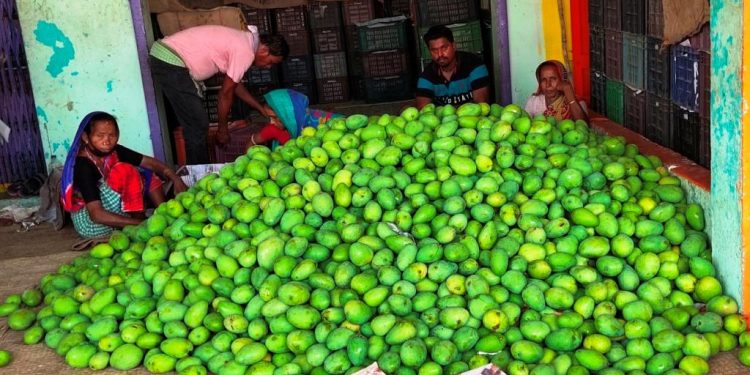Bhubaneswar: This year, despite the prolonged spell of heatwave in the state, the mango farmers of Odisha are poised to earn more from the lower fruit harvest. In addition, farmers based in the rich mango-producing belts such as Gajapati, Rayagada, Dhenkanal and Puri districts have alluded to depleting levels of moisture owing to sparse rainfall, which brought down the production and sent the prices zooming in local markets. Weather experts claimed this year’s summer, between mid-April and May, was the harshest in the last two decades.
With a total of 27 heatwave days and temperatures exceeding 40 degrees Celsius in more than 15 districts, the trees had frequent felling of mangoes. The weather conditions also harmed size, weight and quality of the fruits, they added. Krushna Mohapatra, 58, who owns a 60-acre mango orchard in Kashipur block of Rayagada district, said production has been slashed to less than 50 per cent this year, in comparison to the previous one. His orchard grows mangoes such as Langda, Daseri, Amrapalli, Sundari and Akhurasa. But what stands out among these varieties is Amrapali, Krushna added, saying that the variety is barely available this year due to lack of flowering in the trees. “Last year, there was an endless harvest of Amrapali variety in my farm; hence, it saw a regular supply to the market till June-end. However, this year we are selling Amrapali mangoes to traders at four times the normal price due to non-availability.
Similarly, the Daseri variety is being sold at Rs 40 to traders, a hike of Rs 10 from the last year. This year, we are expecting to harvest 500 baskets against the typical 2,000 baskets per year. The prices would go northwards due to lower supply and farmers would benefit the most out of it,” he added.
Odisha, according to the National Horticulture Board (NHB), is the eighth-largest producer of mangoes in India, with an annual production of 847.81 tonnes. This year, however, due to inadequate precipitation the size and quantity of the fruit got affected, claimed an expert, adding the weight of Langda and Amrapali mangoes is now 150 gram against their original of 300 gm. Typically, mango, unlike other fruits, doesn’t require high-volume of water or fertilizer supply. Hence, growing mangoes is regarded the best option by farmers as it involves less risk and high returns. Another farmer, Ajit Sahu of Mohana block in Gajapati district, said this year he sold Langda at Rs 40 per kilo against previous year’s Rs 30. In several places across Gajapati district, farmers have sold Langda at a profit of Rs 15 against last year’s price, while Amrapali variety has been sold at a profit of Rs 30.
Similarly, he added that last year around nine mangoes of Langda variety made up a kilo. In a sharp contrast, this year even 12 Langda mangoes struggle to weigh a kilo. “Hence we are bound to raise the price by Rs 10 per kilo to incur profit,” Ajit said. At present, prices of Langda and Amrapali are quoted at Rs 60 and Rs 80 per kg compared to Rs 45 and Rs 90 in the corresponding period last year.
Putting these theories at bay, Assistant Director of Horticulture at Ekamra Kanan, Chittaranjan Sahoo said regular ploughing of fields and ensuring adequate presence of moisture are key factors to grow good quality mangoes. “If a tree fails to bear fruits during peak harvest seasons of April-May, then certainly it did not receive surplus nourishment in the form of good soil and water. Not every time, the harsh climatic conditions play a spoilsport in the growth of mangoes. Hence, it is necessary for farmers to build favourable micro-climate for mango trees for sustainable growth,” he added.
DEBADURLLAV HARICHANDAN, OP
